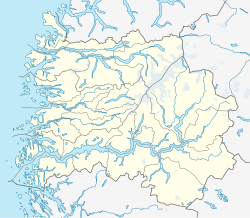Kaupanger Stave Church
| Kaupanger Stave Church | |
|---|---|
| Kaupanger stavkyrkje | |

View of the church
|
|
| 61°11′03″N 7°14′00″E / 61.184167°N 7.233333°ECoordinates: 61°11′03″N 7°14′00″E / 61.184167°N 7.233333°E | |
| Location |
Sogndal Municipality, Sogn og Fjordane |
| Country | Norway |
| Denomination | Church of Norway |
| Churchmanship | Evangelical Lutheran |
| Architecture | |
| Status | Parish church |
| Functional status | Active |
| Completed | c. 1140 |
| Specifications | |
| Capacity | 125 |
| Materials | Wood |
| Administration | |
| Parish | Kaupanger |
| Deanery | Indre Sogn prosti |
| Diocese | Diocese of Bjørgvin |
| Kaupanger Stave Church | |
|---|---|
| Type | Church |
| Status | Automatically protected |
| County | Sogn og Fjordane |
| Municipality | Sogndal |
| Year built | Mid-12th century |
| ID | 84766 |
Kaupanger Stave Church (Norwegian: Kaupanger stavkyrkje) is the largest stave church in Sogn og Fjordane county, Norway. It is located in the village of Kaupanger in Sogndal Municipality, on the northern shore of the Sognefjorden. It is still in use as a parish church, having been in use continuously since its completion in the mid-12th century. The church is part of the Kaupanger parish in the Indre Sogn deanery in the Diocese of Bjørgvin.
The church is a Norwegian Cultural Heritage Site. The nave is supported by 22 staves (large bearing columns), 8 on each of the longer sides and 3 on each of the shorter. The elevated chancel is carried by 4 free standing staves. The church has the largest number of staves to be found in any one stave church. It is the largest of the five stave churches in Sogn og Fjordane county.
Kaupanger Stave Church was built in the mid-12th century. It is situated on the ruins of what might be two previous post churches. Kaupanger was a market town that King Sverre burned down in 1184 to punish the local inhabitants for disobeying him. It was previously thought that the stave church previously standing on this site burned down in this fire, as archaeological research in the 1960s revealed that the previous church had burned down. The present church was therefore believed to have been built around 1190. Recent research has changed these assumptions. Dendrochronology has shown that the timber used for building the church was cut in 1137. Also, Sverris saga makes no mention of the burning of the church at the time the town was burnt. Consequently, it is now assumed that the church was built around 1150.
...
Wikipedia


